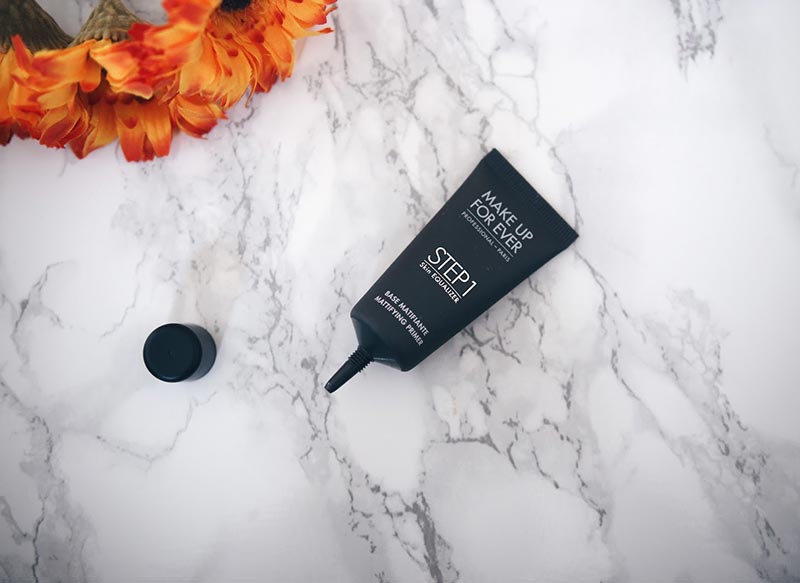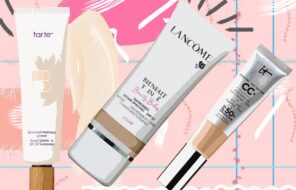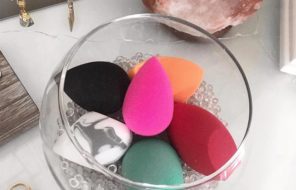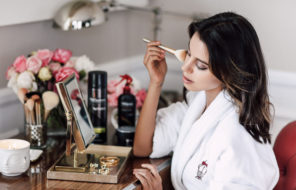Do you use primer every day, or just for special occasions? Do you know what it is and whether you really need one? Do you know how to apply makeup primer correctly? We cover all these bases in this article, so you can really lay down a flawless base. Learn how to use makeup primer, so you can apply it flawlessly.
In this article:
What Is Makeup Primer?
A makeup primer is a unique product that straddles the line between makeup and skin care, and yet does not quite fit into one or the other. Makeup primers are lotion or cream-based formulas that are applied to the skin before foundation (or occasionally in its stead).
Their purpose is to sit on top of the skin, where they will fill in any gaps between pores and wrinkles, thereby turning the skin into a smoother canvas to which it is easier to apply foundation. Makeup primers also act as a shield, separating the foundation from the skin and preventing any of its ingredients becoming absorbed by the skin.
This also means that foundations that are applied over makeup primers tend to last much longer, and the skin ends up looking smooth and flawless for many hours.
Do I Need a Makeup Primer?
So while I do not think makeup primers are a mandatory makeup step, it is totally up to you to decide for yourself. You should definitely add a primer to your makeup routine if any of the following applies to you:
- Your foundation doesn’t last as long as you would like it to, despite setting it with powder.
- Your skin texture is uneven either due to large pores, fine lines and wrinkles, scarring, dryness, or any other reason, and you find it difficult to apply foundation over it.
- Your skin produces a lot of oil, and gets shiney throughout the day even with face powder.
- You find that most foundations oxidize (i.e. become a different shade, normally a little more orange or a little darker than what it was in the tube) after being applied to your skin.
You might also consider using a primer if you simply like the luxury of it, if you find other benefits to it (like sunscreen or color correction), or if you find that it makes your foundation application a little bit easier, and don’t mind taking the extra time to apply it.
How to Apply Makeup Primers?
Applying a makeup primer is easy as pie, as long as you follow these steps:
- A clean canvas is key, so make sure to use a gentle face cleanser to remove all impurities from your skin. A full cleansing is rarely necessary in the morning, so swiping a cotton pad saturated with micellar water (La Roche Posay Micellar Water, available at Ulta, is an excellent choice) in upward, circular motions will more than suffice.
- If your skin leans towards oily you might find you don’t need to moisturize before applying a primer, but for most people it is a good idea. Choose a light moisturizer that will be quickly absorbed by the skin, like the Clinique Dramatically Different Moisturizing Gel, from Sephora. Apply it to the skin in circular, upward motions, and then wait 5-10 minutes for it to fully absorb.
- If it is daytime, and your primer does not have an SPF, apply a sunscreen and went 20 minutes for it to sink into the skin. Waiting ensures that your primer will not disturb your sunscreen and water down its SPF.
- Squeeze out a pea sized drop of your primer into your hand. Using your fingers, dot it along your forehead, cheeks, nose, and chin.
- With smooth motions, use the palm of your hand to smooth the primer all over your skin, in downward motions, beginning at the center of the face and working outwards. You want the primer to be spread as thinly over your skin as possible, but you also want to work fast, because the primer won’t blend nicely once it starts to dry.
- If you are only using primer, without foundation, then you are done!
- If you do intend to wear makeup, wait 5 minutes to allow the primer to fully settle. Then finish off with a buttery-smooth foundation application, and any other makeup steps you normally follow.
Makeup Primer Hacks
- Makeup primers can help sheer out almost any cream or liquid-based foundation. If you have a full-coverage foundation that you want to turn into something lighter and more natural looking, simply blend it with a few drops of foundation right before applying.
- Primer can double as a very light brow pomade, if you happen to be out of eyebrow wax. Apply a tiny drop with a clean spoolie brush, and it will keep your brows from becoming unruly.
- If you are using makeup primers for oil control or for strobing, you don’t have to apply them all over the face. You can reserve illuminating primers for the high points of your face where you want extra shine, and only apply mattifying primers to areas like the forehead and nose, where you want to control excess oil production.
- Mattifying makeup primers can mattify more than just your skin. To make any lipstick matte, apply a few drops of mattifying primer over it.
- For a longer lasting lipstick application, you can even apply primer all over the lips before putting on lipstick. You can also skip the lip liner, by applying a touch of makeup primer along the edges of your lips.
- If you already have fairly even toned skin, a primer will be more than enough to diffuse imperfections like large pores or fine lines, so you can confidently go out makeup-free!
Photo via @makeupforever





